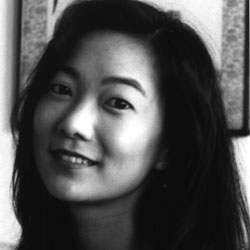tend their yard every weekend,
when they paint or straighten
the purple fencepickets canting
each other at the edge of their lot,
hammering them down into soil
to stand. How long will they stay
put? My neighbors mend their gate,
hinges rusted to blood-colored dust,
then weave gold party-lights with
orange lobster-nets & blue buoys
along the planks. So much to see
& not see again, each chore undone
before they know it. I love how
faithfully they work their garden
all year, scumbling dried eelgrass
in fall, raking away mulch in spring.
Today the older one, Pat, plants
weeds ripped from a cranberry bog.
Sassafras & pickerel, black locust
& meadowsweet, wild sarsaparilla,
checkerberry, starflower. Will they
take root here? Meanwhile Chris waters
seeds sown months ago. Furrows
of kale, snapbean, scallion break
the surface, greedy for life. Muskrose
& lilac cast their last shadows. Is it
seeing or sun that makes them flicker,
as if they’ve vanished? They shake
like a letter in someone’s hand.
Here come the guys from Whorfs
(“Whores”) Court, walking their dog
– also in drag – to the dunes.
I miss seeing Disorient Express
(a.k.a. Cheng, out of drag) walk by,
in tulle & sequins the exact shade
of bok choi. He must have survived
things no one can name, to name only
KS, pneumocystis, aplastic anemia.
I remember he walked off his gurney
when the ambulance came, then broke
his nurse’s fingers in the hospital
when he tried to change his IV line,
wanting to live without meds. Zovirax,
Ativan, leucovorin? I don’t know.
My neighbors pack down the loose dirt.
I’ll never know what threads hold
our lives together. They kiss, then fall
on the grass. I should look away but don’t.
Notes on the Poem
The title of Suji Kwock Kim's poem "The Couple Next Door" sweeps directly into a sentence that has the subjects in vibrant action, establishing wonderful immediacy and intimacy. Kim clearly feels warmth and affection for either the real-life persons who inspired the poem or the imagined persons she wishes she had as neighbours. Although the poem has a tidy four-line stanza structure, the thoughts and observations spill from stanza to stanza, brimming with life and colour. As the stanzas tumble joyfully one after another, Kim juxtaposes images of luscious and diverse growth, both beautiful and nourishing, with - abruptly - disease and suffering. With almost perverse spirit and optimism, the "things no one can name" are catalogued with pharmaceuticals almost as exotically named as the couple's bountiful and lovingly tended garden. The center of the poem is the phrase "greedy for life". It's perfectly placed. The last stanza is self-contained, starting and ending its sentences within the confines - safe, cozy, secure - of four lines. While Kim confesses: "I'll never know what threads hold our lives together." she's obviously profoundly grateful for the connection.
